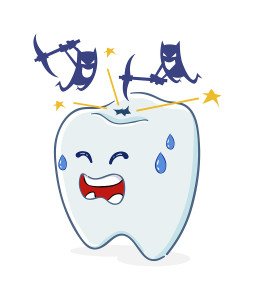Cavities: Why Do My Teeth Hurt?
 Human teeth are designed to bite into some fairly hard and tough materials. Beef jerky, taffy, hard candy, and of course the classic standbys of denture commercials: apples and corn. It’s generally not a good idea to chew on solid objects like rocks and wood, but then that’s a fairly obvious conclusion we can make without having to feel our mistakes in our teeth. So then why can they hurt? What good does that do us?
Human teeth are designed to bite into some fairly hard and tough materials. Beef jerky, taffy, hard candy, and of course the classic standbys of denture commercials: apples and corn. It’s generally not a good idea to chew on solid objects like rocks and wood, but then that’s a fairly obvious conclusion we can make without having to feel our mistakes in our teeth. So then why can they hurt? What good does that do us?
Anatomy Of A Tooth
From outermost layer to innermost, a tooth consists of enamel, cementum, dentin, and pulp. Enamel is the outermost layer of a tooth and forms the crown, which is the part of the tooth which you can see without cutting into the gums. It is almost completely mineralized, which means it is very hard, very brittle, and it tends to dissolve easily when exposed to acid and bacteria which feed on sugars. Meanwhile, cementum is the outer layer of the tooth which exists below the gums, and like its name suggests, cementum acts to secure the tooth in the tissue around it.
Dentin is the middle part of the tooth, and as such it’s partly mineral and partly organic. It’s less brittle than enamel, so it acts as a sort of shock absorber, plus the organic parts of dentin act as an early warning system if the enamel wears away.
In the core of every tooth is the pulp, a set of nerves and blood vessels which aren’t strictly necessary once the tooth has finished growing. However, what they can do is provide a warning system that lets you know that a tooth is in danger of wearing away and getting infected.
A Drill In Time
When your dentist spots a cavity early on, he or she does not need to take exceptional measures to fix it. It’s simply a matter of drilling away the decaying enamel and dentin and filling the hole with something less prone to decay.
However, if the cavity reaches your tooth pulp, there’s a chance the nerves and blood vessels could get infected and start moving the infection out into the rest of your body. If something like that happens, then it’s time to perform a root canal. A root canal involves cutting open half the crown or more in order to scrape out all the pulp, right down to the bits which extends down the thin roots. This effectively renders the tooth dead, and usually the dentist will have to replace the entire crown thanks to all the damage.
Our teeth are meant to be tough, but like the rest of our bodies they need support and oversight. While we may not technically need to feel our teeth, it’s much harder to keep track of their health when we can’t.